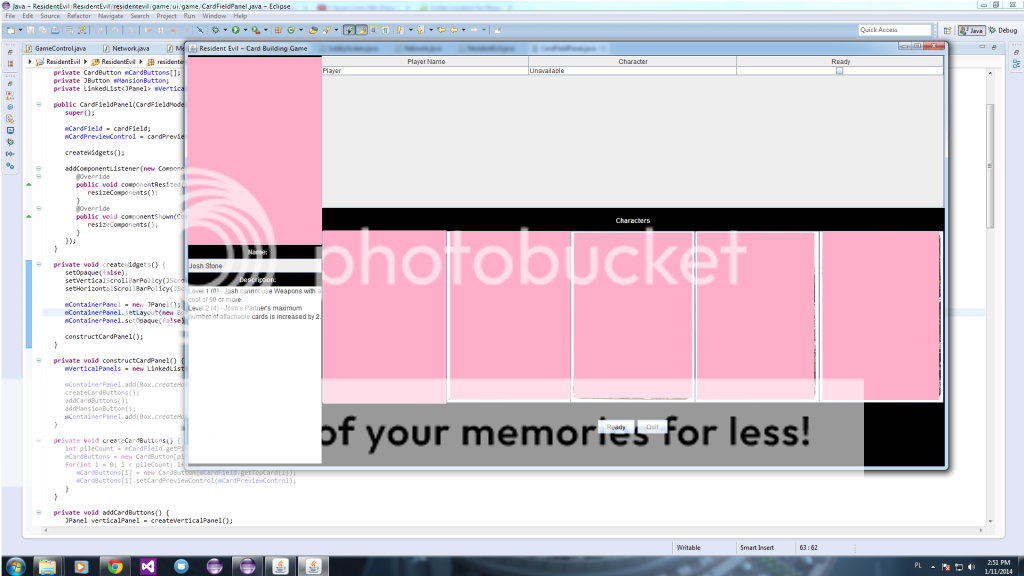Have you ever been told, or told someone not to unroll their own gui framework but to rely on the established available libaries? Well, this pretty much shows why they are right:
TowerStateCtrl::TowerStateCtrl(gui::Widget& parent, const ecs::Entity& tower, const ecs::MessageManager& messages): m_pTower(&tower), m_pMessages(&messages)
{
gui::Area& area = AddWidget<gui::Area>(0, 0, parent.GetWidth(), parent.GetHeight());
SetAsMainWidget(&area);
parent.AddChild(area);
const int imageX = parent.GetWidth()/12;
const int imageY = parent.GetHeight()/12;
const int imageWidth = parent.GetWidth() - imageX*2;
const int imageHeight = parent.GetHeight() - (int)(imageY*3.75f);
AddWidget<gui::Image>(imageX, imageY, imageWidth, imageHeight, L"GuiStateback");
const Tower* pTower = m_pTower->GetComponent<Tower>();
// name display
m_pNameLabel = &AddWidget<gui::Label>(0, area.GetHeight() / 16, area.GetWidth(), 32, pTower->m_stName.c_str());
const int iconSize = area.GetWidth() / 20;
const int iconOffsetX = area.GetWidth() / 8;
const int offsetX = iconOffsetX + iconOffsetX;
const int offsetY = area.GetHeight() / 7;
const int halfWidth = area.GetWidth() / 2;
const int labelWidth = halfWidth - offsetX;
const int labelOffsetX = offsetX + labelWidth;
// damage display
AddWidget<gui::Image>(iconOffsetX, offsetY, iconSize, iconSize, L"IcoThunder");
gui::Label& damageLabel = AddWidget<gui::Label>(offsetX, offsetY, labelWidth, 32, L"Damage");
damageLabel.SetAlign(gui::LEFT | gui::VCENTER);
m_pDamageLabel = &AddWidget<gui::Label>(labelOffsetX, offsetY, labelWidth, 32, conv::ToString( pTower->m_atk ).c_str() );
m_pDamageLabel->SetAlign(gui::RIGHT | gui::VCENTER);
// speed display
AddWidget<gui::Image>(iconOffsetX, offsetY*2, iconSize, iconSize, L"IcoHourglass");
gui::Label& speedLabel = AddWidget<gui::Label>(offsetX, offsetY*2, labelWidth, 32, L"Speed");
speedLabel.SetAlign(gui::LEFT | gui::VCENTER);
m_pSpeedLabel = &AddWidget<gui::Label>(labelOffsetX, offsetY*2, labelWidth, 32, conv::ToString( pTower->m_speed ).c_str() );
m_pSpeedLabel->SetAlign(gui::RIGHT | gui::VCENTER);
// range display
AddWidget<gui::Image>(iconOffsetX, offsetY*3, iconSize, iconSize, L"IcoWorld");
gui::Label& rangeLabel = AddWidget<gui::Label>(offsetX, offsetY*3, labelWidth, 32, L"Range");
rangeLabel.SetAlign(gui::LEFT | gui::VCENTER);
m_pRangeLabel = &AddWidget<gui::Label>(labelOffsetX, offsetY*3, labelWidth, 32, conv::ToString( pTower->m_range ).c_str() );
m_pRangeLabel->SetAlign(gui::RIGHT | gui::VCENTER);
// level display
AddWidget<gui::Image>(iconOffsetX, offsetY*4, iconSize, iconSize, L"IcoStar");
gui::Label& levelLabel = AddWidget<gui::Label>(offsetX, offsetY*4, labelWidth, 32, L"Level");
levelLabel.SetAlign(gui::LEFT | gui::VCENTER);
m_pLevelLabel = &AddWidget<gui::Label>(labelOffsetX, offsetY*4, labelWidth, 32, conv::ToString( pTower->m_level + 1 ).c_str() );
m_pLevelLabel->SetAlign(gui::RIGHT | gui::VCENTER);
// upgrade button
const int buttonY = (int)(offsetY * 5.75f);
m_pUpgradeButton = &AddWidget<gui::Button>(16, buttonY, halfWidth - 32, area.GetHeight() / 6, (L"Upgrade:" + conv::ToString( 50 )).c_str() );
m_pUpgradeButton->SigReleased.Connect(this, &TowerStateCtrl::OnUpgradeTower);
const int iconOff = (m_pUpgradeButton->GetHeight() - iconSize) / 2;
gui::Image& sell = AddWidget<gui::Image>(iconOff, iconOff, iconSize, iconSize, L"IcoUpgrade");
sell.OnDisable();
m_pUpgradeButton->AddChild(sell);
// sell button
m_pSellButton = &AddWidget<gui::Button>(halfWidth + 16, buttonY, halfWidth - 32, area.GetHeight() / 6, (L"Sell:" + conv::ToString( (int)(pTower->m_cost * 0.75) )).c_str() );
m_pSellButton->SigReleased.Connect(this, &TowerStateCtrl::OnSellTower);
gui::Image& money = AddWidget<gui::Image>(iconOff, iconOff, iconSize, iconSize, L"IcoMoney");
money.OnDisable();
m_pSellButton->AddChild(money);
Update();
OnFocus(true);
}
That monstrousity just to display a small status-widget, without any functionality mind you. I probably could have used more constants (yieks!) or seperated this huge method into smaller ones, but its a mess anyway. Anyone else here who encountered their own "gui horrors"? ![]()











